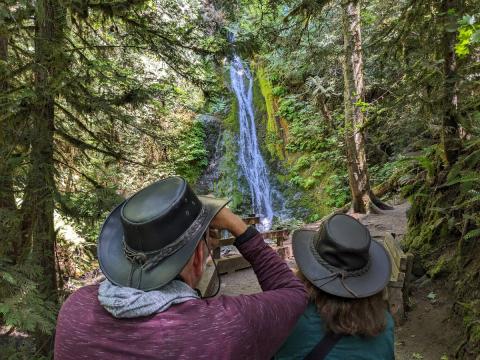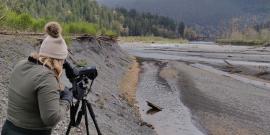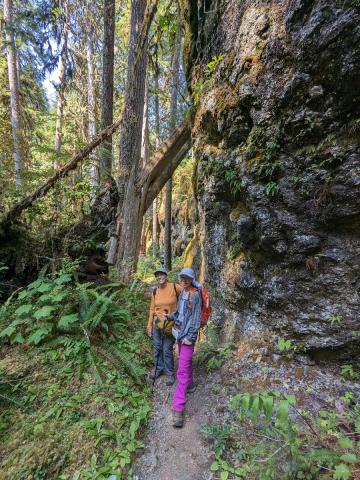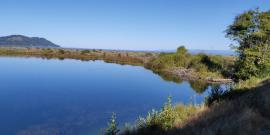
Exploring the Elwha River with Experience Olympic
The Elwha River is a great educational and hiking destination and the mouth of the Elwha is good for birding.
Private flexible-scheduled guided day tours to the Elwha River are geared towards students, educators, and those from the public who are interested in history, river ecology, and habitat restoration. Lynda Mapes book Elwha A River Reborn is a great resource.
Visiting the Elwha is best enjoyed with a guide because the Olympic Hotsprings Road has been closed to vehicles at the park entrance since 2017 and many of the locations visited are outside the park.
The Elwha River's return to wild
Explore riparian, upland, and restoration forest ecology on a wild and free Elwha River with a former member of the Elwha Wildlife Research Tream.
From 2011-2014, two ~100 year old dams on the Elwha River were removed leading to the return of salmon and marine derived nutrients to the forested mountain valley.
The Elwha River drains close to twenty percent of Olympic National Park’s near one million acres, highlighting the extent of pristine salmon habitat tied to the Elwha River Restoration.

What is there to see on a Restored Elwha River?
A restored Elwha River is a fascinating tour location because it is the setting for the ultimate science experiment on the Olympic Peninsula. The Elwha River is blazing new and healthier side channels and creating the environmental conditions that fish love.
Maintaining infrastructure on a wild and free river has led to lack of vehicle access into the upper reaches of the river but there is still much to see in the lower watershed. Sites visited on an Elwha River tour might include the sites of the former Elwha Dams and former reservoirs, the wildlife-rich river mouth, and Madison Falls.
Politics and Elwha River Dam removal
The historic Elwha and Glines Canyon dams were removed between 2011-2014 due to lack of salmon passage (illegal since Washington was a territory) and age (inefficiency) of the structures.
At the time dam removal was considered, the combined power output of both dams could not even meet 50% of the electrical demands of the paper mill in Port Angeles.
Thanks to public pressure, Congress enacted the Elwha River Ecosystem and Fisheries Restoration Act in 1992 that mandated the removal of the dams.
The connection between Dam Removal and Restoration
What does river restoration have to do with dams? River restoration is essentially the process of allowing the natural unimpeded flow of a river from the mountains to the ocean as well as directing native plant re-establishment in the former reservoirs.
The Lower Elwha Dam was illegal since it blocked fish passage upon construction starting in 1910. The Glines Canyon Dam, which eventually was located in Olympic National Park, was up for license renewal in 1977 (50 years after construction). Luckily, environmentalists saw an opportunity for the Elwha River Restoration at the time of re-licensing.
Wildlife on a Restored Elwha River
Research was initiated between 1992 and 2011 to study marine-derived nutrients as well as myriad of other topics related to dam removal.
Twenty two wildlife species have been found to enjoy dining on salmon and when these animals (like black bear) leave the river, some of those nutrients pass through their bodies.
Plants require certain nutrients to grow and thus the entire ecosystem benefits from the reintroduction of salmon to a river.
Woody debris on a Restored Elwha River
River erosion causes many large trees to fall into the river. However, many of these trees (aka woody debris) had been trapped behind the former reservoirs as water slowed down and could no longer provide the force needed for debris movement.
Additionally, stumps with springboard notches that were harvested before the dams were installed were revealed post dam removal.
Large woody debris is important in the formation of log jams that provide the dynamic nature of wild waterways as well as the protection needed for “aquarium-like” environments for young salmon.
Sediment on a Restored Elwha River
The Olympic Mountains are largely comprised of sediments that have settled on the bottom of an ancient ocean. These sediments were consolidated and uplifted to form the Olympic Mountains but are still highly erosive, especially when exposed to winter storms, snowmelt, flooding and other erosive events.
Sediment will travel down rivers during floods, forming deltas and sandy estuaries. Forage fish are already repopulating the newly sandy Elwha River mouth, delta, and sandspit in order to become an important food source for wild Pacific salmon as well as for other wildlife.
Restoring Habitat in the Former Elwha Reservoirs
In terraces of nutrient-poor sediments close to the Elwha river floodplain, deliberately planted trees and shrubs like Western White Pine are growing next to volunteer stands of Red Alder.
Riverbank Lupine fix nitrogen and will help revitalize the nutrient-poor substrate found on the former reservoir sites. This lupine species was not typical in the Elwha River watershed prior to dam removal but is a good pioneer species.
The three main goals of Elwha River re-vegetation in these sites has been to minimize invasive species, restore ecosystem processes, and accelerate forest development.
How the Elwha compares to the Hoh Rainforest
Olympic National Park's Elwha River Valley forests are not technically defined as rainforest because there is not sufficient yearly rainfall to meet that criteria. However, most of the same wildlife and plant species are present.
The Elwha River Valley includes a plethora of hiking trails that are typically less crowded and less impacted by humans and elk when compared to the Hoh Rainforest. Douglas Fir and Western Hemlock dominate in the Elwha, while Sitka Spruce largely replaces Douglas Fir in the Hoh Rainforest because of the increased levels of rainfall.



